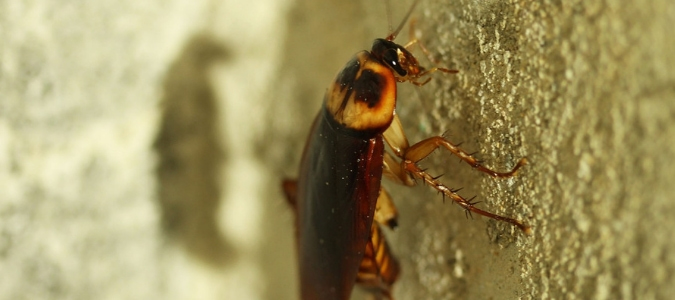Roaches in My Microwave: What Can I Do?

If you don’t regularly clean out your microwave, little bits of food can accumulate inside and attract roaches. Cockroaches love to feed on grease as well, so covering dishes before you microwave them and wiping out the interior of your microwave every time you use it, preferably with a cleaner that contains bleach, will go a long way toward keeping roaches away from this kitchen appliance.
Keeping the kitchen clean will also help to reduce cockroach populations in general. The places where roaches are most often found in people’s homes include bathrooms, utility rooms and kitchens. All three areas can give roaches access to the water they need to survive. And, since roaches can feed on non-food items like cardboard, particleboard and fabric, bathrooms and utility rooms can supply these pests with everything they need to survive.
But kitchens are full of actual, tasty food for roaches to enjoy. This is especially true if you aren’t always careful about wiping up crumbs, spills and grease splatters. Furthermore, lots of people feed their pets near the kitchen, and pet food and water bowls are another food source for roaches. So are trash and recycling bins that don’t have tightly fitting lids. Remember that cockroaches are relatively flat and can squeeze through very small openings. Waste bins and food storage containers, including pet food containers, need to have tightly fitting lids to be safe from cockroaches.
Unfortunately, cleaning your kitchen thoroughly, covering all waste bins, emptying out your pets’ bowls every night and regularly bleaching your microwave will only go so far if roaches have already moved in. So what can you do if you find roaches living in your microwave? Unfortunately, these pests have an uncanny ability to live through being heated up during regular microwave use. The best way to get rid of cockroaches is by using a combination approach, meaning several different techniques that complement and support one another.
Sanitation is the first step. Keep the kitchen as clean as possible, store trash in closed bins, and wipe down counters, the microwave and the stovetop every day. It’s also important to store food, including pet food, in airtight containers, and sweep or vacuum up crumbs.
The next step is addressing minor issues around the home that you might not even realize can be related to pest infestations. This includes fixing any plumbing issues like leaky faucets or pipes that might be attracting roaches due to their need for water. Since several types of cockroaches come into people’s homes from outside, it’s important to fix gaps in window screens or around windows, doors or vents. Look for any small openings where roaches might be slipping in. Similarly, replace worn-out door thresholds, so roaches and other insects can’t crawl through.
Clutter in general is another factor in people’s homes that can lead to cockroach infestations, and especially paper clutter. If you have lots of paper products in your home, such as cardboard boxes, books, newspapers and magazines, you may want to consider getting rid of them or storing them elsewhere. Roaches feed on paper as well as the glue that binds books and magazines together. They also feed on cardboard boxes, so if you have storage items, you might transfer them to plastic bins or store them in a climate-controlled storage facility instead of inside your home.
Once you have taken these steps, it’s time to get rid of any roaches that have already infested the area. Often, the best technique is to enlist help from a pest control professional. A professional can inspect the area and determine the best combination of solutions to control the roach problem. Too many times, trying to get rid of a roach infestation on your own is just an exercise in frustration and wasted time. A pest control specialist can use the best products and techniques to help you reclaim your home from pests and keep them away.
If you find roaches in your microwave, you’re probably wondering, how do roaches get in your house in the first place?

How Do Roaches Get in Your House?
The answer to this question depends on the type of roach infesting your home. American and Oriental cockroaches are larger types of roaches that are found throughout the U.S., and especially in areas with warmth and humidity. These cockroaches are medium to dark brown in color and grow to an inch or longer as adults. They have wings that they occasionally use to fly, but mostly, they run unnervingly fast.
American and Oriental cockroaches live outdoors in damp leaves and dirt. They can sneak into people’s homes through tiny gaps and openings. If your door doesn’t close completely, if there are weep holes in your exterior walls, or if there are gaps in the screens on your windows or around pipes or vents leading into your home, a roach can get in. These roaches may also enter your home along water or sewage pipes, which is one reason they are often seen in bathrooms and utility rooms.
When comparing German and American cockroaches, German roaches are much smaller. Unfortunately, they are even more likely to infest a home. If you see a larger roach, it may just be a single insect that wandered indoors. But, seeing even one German roach usually indicates a population nearby. German roaches tend to be introduced to a home during a move from a different home, on secondhand goods or furniture, or even in grocery bags.
Whichever type of roach you’re dealing with and wherever it came from, it probably came in seeking shelter, water and food. If roaches can find plenty of all three inside, they will happily stay and reproduce, and eventually infest your home if they aren’t eliminated. This is why it’s so important to act once you realize your home has a roach problem.
The most efficient way to get rid of these pests is to reach out to a pest control specialist to make a thorough inspection and assessment of the situation. Then, your specialist can create a customized treatment plan that targets roaches. This way, you don’t have to worry about keeping roaches away while you sleep.
If you have a dog, you may have seen it go after a roach with the same gusto it might have when it’s chasing a squirrel across the yard. But can dogs eat roaches?

Can Dogs Eat Roaches?
The quick answer is yes, they can—there’s just something about a quick-moving critter that activates some dogs’ predatory instincts.
If you’re concerned for your dog’s health if he eats a roach, rest assured that there shouldn’t be too much cause for concern. Of course, it’s always wise to watch your pet for signs of illness and contact your veterinarian with any questions or concerns. Just don’t rely on your furry friend for any amount of natural pest control. While dogs may occasionally eat roaches, they definitely won’t eat enough to keep roach populations down inside your home. The same goes for dogs and a mouse infestation.
Dogs can come in handy in identifying a cockroach infestation that you may not have been aware of previously. If you notice your dog is chasing or even catching lots of roaches on a regular basis, it’s a good sign that you have a roach problem in your home or yard, or both. Trying to control a pest infestation on your own can lead to lots of frustration, ultimately prolonging the problem. Contacting a pest control specialist to treat the infestation using the best and safest products and techniques is often the quickest way to restoring your peace of mind.
Chem-free Can Get Your Cockroach Problem Under Control
Whether you find a cockroach in your microwave, on the bathroom counter or outside by your shed, you likely don’t want to find another one. Chem-free will create a customized pest control plan to get your roach infestation under control. We can also recommend holistic measures to aid in our treatment plans, such as getting your weatherstripping replaced and taking your trash out nightly.
Need Help Managing Pests?
Chem-Free offers both effective, low-impact pest control options and preventative measures to help avoid future infestations. Contact us today for a free estimate!


